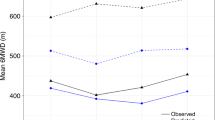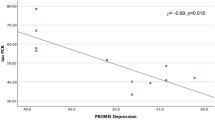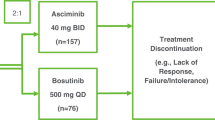Abstract
We previously described impairments in quality of life (QOL) and physical function among acute myeloid leukemia (AML) survivors between diagnosis and 1 year. The aim of the current study is to describe and compare to normative data QOL and physical function recovery over 3 years from diagnosis and treatment with intensive chemotherapy (IC). At assessments done at baseline (pre-IC) and at 11 time points over 3 years, QOL, fatigue, and 3 physical performance measures (PPMs; grip strength, 6-min walk test (6MWT), and timed chair stands) were collected. Long-term recovery was defined by reaching scores within the minimum clinically important difference of normative data. Global QOL recovery was seen in 79% at 1 year, 75% at 2 years, and 86% at 3 years. At 3 years, the QLQ-C30 subscales with the greatest recovery were physical and emotional functioning. For FACT-fatigue, recovery was seen in 68% at 1 year and 77% at 3 years. Recovery on PPMs was poorer on average, with only 17% on the 6MWT and 42% in grip strength returning to normal at 3 years. The vast majority of AML survivors after IC achieve recovery in QOL and fatigue by three years. However, recovery in physical performance remained blunted.
This is a preview of subscription content, access via your institution
Access options
Subscribe to this journal
Receive 12 print issues and online access
$259.00 per year
only $21.58 per issue
Buy this article
- Purchase on Springer Link
- Instant access to full article PDF
Prices may be subject to local taxes which are calculated during checkout



Similar content being viewed by others
References
Bower H, Andersson T, Njorkholm M, Dickman PW, Lambert PC, Derolf. R. Continued improvement in survival of acute myeloid leukemia patients: an application of the loss in expectation of life. Blood Cancer J. 2016;6:e390.
Juliusson G, Antunovic P, Derolf A, Lehmann S, Mollgard L, Stockelberg D, et al. Age and acute myeloid leukemia: real world data on decision to treat and outcomes from the Swedish Acute Leukemia Registry. Blood. 2009;113:4179–87.
Tamamyan G, Kadia T, Ravandi F, Borthakur G, Cortes J, Jabbour E, et al. Frontline treatment of acute myeloid leukemia in adults. Crit Rev Oncol Hematol. 2017;110:20–34.
Derolf AR, Kristinsson SY, Andersson TM, Dickman PW, Bj€orkholm M. Improved patient survival for acute myeloid leukemia: a population-based study of 9729 patients diagnosed in Sweden between 1973 and 2005. Blood. 2009;113:3666–72.
Pulte D, Gondos A, Brenner H. Improvement in survival in younger patients with acute lymphoblastic leukemia from the 1980s to the early 21st century. Blood. 2009;113:1408–11.
Medeiros BC, Satram-Hoang S, Hurst D, Hoang KQ, Momin F, Reyes C. Big data analysis of treatment patterns and outcomes among elderly acute myeloid leukemia patients in the United States. Ann Hematol. 2015;94:1127–38.
Derolf AR, Kristinsson SY, Andersson TM, Landgren O, Dickman PW, Björkholm M. Improved patient survival for acute myeloid leukemia: a population-based study of 9729 patients diagnosed in Sweden between 1973 and 2005. Blood. 2009;113:3666–72.
Alibhai SM, Leach M, Minden MD, Brandwein J. Outcomes and quality of care in acute myeloid leukemia over 40 years. Cancer. 2009;115:2903–11.
Alibhai SM, Breunis H, Timilshina N, Brignardello-Petersen R, Tomlinson G, Mohamedali H, et al. Quality of life and physical function in adults treated with intensive chemotherapy for acute myeloid leukemia improve over time independent of age. J Geriatr Oncol. 2015;6:262–71.
Mohamedali H, Breunis H, Timilshina N, Brandwein JM, Gupta V, Li M, et al. Older age is associated with similar quality of life and physical function compared to younger age during intensive chemotherapy for acute myeloid leukemia. Leuk Res. 2012;36:1241–48.
Timilshina N, Breunis H, Tomlinson G, Brandwein JM, Alibhai SM. Do Quality of life, physical function, or the Wheatley Index at diagnosis predict 1-year mortality with intensive chemotherapy in older acute myeloid leukemia patients? Leuk Res. 2016;47:142–8.
Aaronson NK, Ahmedzai S, Bergman B, Bullinger M, Cull A, Duez NJ, et al. The European Organization for Research and Treatment of Cancer QLQ-C30: a quality-of-life instrument for use in international clinical trials in oncology. J Natl Cancer Inst. 1993;85:365–76.
Yellen SB, Cella DF, Webster K, Blendowski C, Kaplan E. Measuring fatigue and other anemia-related symptoms with the Functional Assessment of Cancer Therapy (FACT) measurement system. J Pain Symptom Manag. 1997;13:63–74.
Timilshina N, Breunis H, Brandwein JM, Minden MD, Gupta V, O’Neill S, et al. Do quality of life or physical function at diagnosis predict short-term outcomes during intensive chemotherapy in AML. Ann Oncol. 2014;25:883–8.
Finch E, Brooks D, Stratford P, Mayo N. Physical Rehabilitation Outcome Measures II, Second edn. Toronto: Canadian Physiotherapy Association, (2002). 292pp.
Mathiowetz V, Kashman N, Volland G, Weber K, Dowe M, Rogers S. Grip and pinch strength: normative data for adults. Arch Phys Med Rehabil. 1985;66:69–74.
Onder G, Penninx BW, Ferrucci L, Fried LP, Guralnik JM, Pahor M. Measures of physical performance and risk for progressive and catastrophic disability: results from the Women’s Health and Aging Study. J Gerontol A Biol Sci Med Sci. 2005;60:74–79.
McArdle WD, Katch FI, Pechar GS, Jacobson L, Ruck S. Reliability and interrelationships between maximal oxygen intake, physical work capacity and step-test scores in college women. Med Sci Sports Exerc. 1972;4:182–186.
Hinz A, Singer S, Brahler E. Europe European reference values for the quality of life questionnaire EORTC QLQ-C30: Results of a German investigation and a summarizing analysis of six European general population normative studies. Acta Oncol (Madr). 2014;53:958–65.
Cella D, Eton DT, Lai JS, Peterman AH, Merkel DE. Combining anchor and distribution-based methods to derive minimal clinically important differences on the Functional Assessment of Cancer Therapy (FACT) anemia and fatigue scales. J Pain Symptom Manag. 2002;24:547–61.
Cella D, Lai JS, Chang CH, Peterman A, Slavin M. Fatigue in cancer patients compared with fatigue in the general United States population. Cancer. 2002;94:528–38.
Wong SL. Grip Strenght reference values for Canadians aged 6 to 79: Canadian Health Measures Survery, 2007 to 2013. Health Rep. 2016;27:3–10.
Tveter AT, Dagfinrud H, Moseng T, Holm I. Health-related physical fitness measures: reference values and reference equations for use in clinical practice. Arch Phys Med Rehabil. 2014;95:1366–73.
Cuesta-Vargas A, Hilgenkamp T. Reference values of grip strength measured with a Jamar dynamometer in 1526 adults with intellectual disabilities and compared to adults without intellectual disability. PLoS One. 2015;10:e0129585.
Bohannon RW. Hand-grip dynamometry provides a valid indication of upper extremity strength impairments in home care patients. J Hand Ther. 1998;11:258–60.
Csuka M, McCarty DJ. Simple method for measurement of lower extremity muscle strength. Am J Med. 1985;78:77–81.
Newcomer KL, Krug HE, Hahowald ML. Validity and reliability of the timed-stands test for patients with rheumatoid arthritis and other chronic diseases. J Rheumatol. 1993;20:21–7.
Wells G, Beaton D, Shea B, Boers M, Simon L, Strand V, et al. Minimal clinically important differences: review of methods. J Rheumatol. 2001;28:406–12.
Guyatt GH, Osoba D, Wu AW, Wyrwich KW, Norman GR, Clinical Significance Consensus Meeting Group. Methods to explain the clinical significance of health status measures. Mayo Clin Proc. 2002;77:371–83.
Norman GR, Sloan JA, Wyrwich KW. Interpretation of changes in health-related quality of life: the remarkable universality of half a standard deviation. Med Care. 2003;41:582–92.
Osoba D, Rodrigues G, Myles J, Zee B, Pater J. Interpreting the significance of changes in health-related quality of life scores. J Clin Oncol. 1998;16:139–44.
Donaldson GW. Moinpour CM.Learning to live with missing quality-of-life data in advanced-stage disease trials. J Clin Oncol. 2005;23:7380–4.
Bell ML, Fairclough DL. Practical and statistical issues in missing data for longitudinal patient-reported outcomes. Stat Methods Med Res. 2014;23:440–59.
Cannella L, Caocci G, Jacobs M, Vignetti M, Mandelli F, Efficace F. Health-related quality of life and symptom assessment in randomized controlled trials of patients with leukemia and myelodysplastic syndromes: what have we learned? Crit Rev Oncol Hematol. 2015;96:542–54.
Cheng MJ, Hourigan CS, Smith TJ. Adult acute myeloid leukemia long-term survivors. J Leuk). 2014;2:pii:26855.
Schumacher A, Wewers D, Heinecke A, Sauerland C, Koch OM, van de Loo J, et al. Fatigue as an important aspect of quality of life in patients with acute myeloid leukemia. Leuk Res. 2002;26:355–62.
Zittoun R, Suciu S, Watson M, Solbu G, Muus P, Mandelli F, et al. Quality of life in patients with acute myelogenous leukemia in prolonged first complete remission after bone marrow transplantation (allogeneic or autologous) or chemotherapy: a cross-sectional study of the EORTC-GIMEMA AML 8A trial. Bone Marrow Transplant. 1997;20:307–15.
Lesko LM, Ostroff JS, Mumma GH, Mashberg DE, Holland JC. Long-term psychological adjustment of acute leukemia survivors: impact of bone marrow transplantation versus conventional chemotherapy. Psychosom Med. 1992;54:30–47.
Stalfelt AM. Quality of life of patients with acute myeloid leukaemia. Leuk Res. 1994;18:257–67.
Fan HG, Houédé-Tchen N, Yi QL, Chemerynsky I, Downie FP, Sabate K, et al. Fatigue, menopausal symptoms, and cognitive function in women after adjuvant chemotherapy for breast cancer: 1- and 2-year follow-up of a prospective controlled study. J Clin Oncol. 2005;23:8025–32.
Tomaszewski EL, Fickley CE, Maddux L, Krupnick R, Bahceci E, Paty J, et al. The patient perspective on living with acute myeloid leukemia. Oncol Ther. 2016;4:225–38.
Cooper R, Kuh D, Hardy R, Mortality Review Group; FALCon and HALCyon Study Teams. Objectively measured physical capability levels and mortality: systematic review and meta-analysis. BMJ. 2010;341:c4467.
Savard J, Ganz PA. Subjective or objective measures of cognitive functioning-what’s more important? JAMA Oncol. 2016;2:1263–64.
Alibhai SM, Leach M, Kowgier ME, Tomlinson GA, Brandwein JM, Minden MD. Fatigue in older adults with acute myeloid leukemia: predictors and associations with quality of life and functional status. Leukemia. 2007;21:845–8.
Stone P, Richards M, Hardy J. Fatigue in patients with Cancer. Eur J Cancer. 1998;34:1670–6.
Mustian KM, Alfano CM, Heckler C, Kleckner AS, Kleckner IR, Leach CR, et al. Comparison of pharmaceutical, psychological, and exercise treatments for cancer-related fatigue: a meta-analysis. JAMA Oncol. 2017;3:961–68.
Stubblefield MD, Schmitz KH, Ness KK. Physical functioning and rehabilitation for the cancer survivor. Semin Oncol. 2013;40:784–95.
Sehl M, Lu X, Silliman R, Ganz PA. Decline in physican functioning in first 2 years after breast cancer diagnosis predicts 10-year survival in older women. J Cancer Surviv. 2013;7:20–30.
Brown JC, Harhay MO, Harhay MN. Physical function as a prognostic biomarkers among cancer survivors. Br J Cancer. 2015;112:194–8.
Markes M, Brockow T, Resch KL. Exercise for women receiving adjuvant therapy for breast cancer. Cochrane database of systematic reviews: reviews. Chichester (UK): John Wiley & Sons Ltd; 2006. (issue 4).
Knols R, Aaronson NK, Uebelhart D, Fransen J, Aufdemkampe G. Physical exercise in cancer patients during and after medical treatment: a systematic review of randomized and controlled clinical trials. J Clin Oncol. 2005;23:3830–42.
Stricker C, Drake D, Hoyer K-A, Mock V. Evidence-based practice for fatigue management in adults with cancer: exercise as an intervention. Oncol Nurs Forum. 2004;31:963–76.
Cramp F, Prue G, Gracey J. Exercise for treatment of cancer related fatigue. Cochrane database of systematic reviews: protocols. Chichester (UK): John Wiley & Sons Ltd; 2006. (issue 3).
Alibhai SM, Durbano S, Breunis H, Brandwein JM, Timilshina N, Tomlinson GA, et al. A phase II exercise randomized controlled trial for patients with acute myeloid leukemia undergoing induction chemotherapy. Leuk Res. 2015 Aug 28. pii: S0145-2126(15)30365-9.
Galiano-Castillo N, Arroyo-Morales M, Ariza-Garcia A, Sánchez-Salado C, Fernández-Lao C, Cantarero-Villanueva I, Martín-Martín L. The six-minute walk test as a measure of health in breast cancer patients. J Aging Phys Act. 2016;24:508–15.
Klepin HD, Tooze JA, Pardee TS, Ellis LR, et al. Effect of intensive chemotherapy on physical, cognitive, and emotional health of older adults with acute myeloid leukemia. J Am Geriatr Soc. 2016;64:1988–95.
Watson M, Buck G, Wheatley K, Homewood JR, Goldstone AH, Rees JK, Burnett AK. UK Medical Research Council AML 10 trial. Adverse impact of bone marrow transplantation on quality of life in acute myeloid leukaemia patients; analysis of the UKMedical Research Council AML 10 Trial. Eur J Cancer. 2004;40:971–8.
Hanmer J, Hays RD, Fryback DG. Mode of administration is important in US national estimates of health-related quality of life. Med Care. 2007;45:1171–9.
Wood-Dauphinee S. The Canadian SF-36 health survey: normative data add to its value. CMAJ. 2000;163:283–4.
Hopman WM, Towheed T, Anastassiades T, Tenenhouse A, Poliquin S, Berger C, et al. Canadian normative data for the SF-36 health survey. Canadian Multicentre Osteoporosis Study Research Group. CMAJ. 2000;163:265–71.
Author information
Authors and Affiliations
Corresponding author
Ethics declarations
Conflict of interest
The authors declare that they have no conflict of interest.
Electronic supplementary material
Rights and permissions
About this article
Cite this article
Timilshina, N., Breunis, H., Tomlinson, G.A. et al. Long-term recovery of quality of life and physical function over three years in adult survivors of acute myeloid leukemia after intensive chemotherapy. Leukemia 33, 15–25 (2019). https://doi.org/10.1038/s41375-018-0162-5
Received:
Revised:
Accepted:
Published:
Issue Date:
DOI: https://doi.org/10.1038/s41375-018-0162-5
This article is cited by
-
Evaluation of indices for predicting recovery of exercise tolerance in patients surviving allogenic hematopoietic stem cell transplantation
Supportive Care in Cancer (2022)
-
Functional capacity, pulmonary function, and quality of life in hematopoietic stem cell transplantation survivors
Supportive Care in Cancer (2021)
-
Impact of age, functional status, and comorbidities on quality of life and outcomes in elderly patients with AML: review
Annals of Hematology (2021)
-
Precision-based exercise as a new therapeutic option for children and adolescents with haematological malignancies
Scientific Reports (2020)
-
Health-related quality of life, symptom burden, and comorbidity in long-term survivors of acute promyelocytic leukemia
Leukemia (2019)



